Earlier this year, The Lutheran invited readers to submit reflections on their favorite Bible characters and stories. We chose to share this collection in Advent as we ponder the Word becoming flesh to be among us.
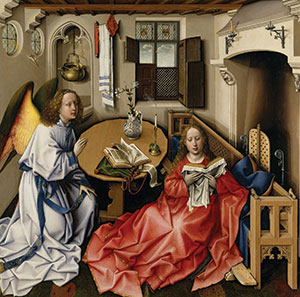
“Merode Altarpiece Tripych,” center panel (c. 1425-1428); oil on wood panel by Robert Campin (1375-1444; Flemish); Metropolitan Museum of Art, N.Y.
From the Hebrew midwives who risked everything to protect baby Moses to the story of the bronze serpent, the Bible characters and stories readers chose weren’t what we expected. Yes, there were some classic stories and characters, but where were Peter, Jonah and Martha? What about the story of the great flood or, my personal favorite, the story of the prodigal son?
No two entries were alike. Instead, this was a kaleidoscope of carefully selected biblical people and stories that reflect the diversity of the body of Christ. And the submissions were highly personal, often weaving Scripture into everyday realities. The responses were so powerful that rather than pull out snippets and highlight trends (which would have been near impossible), we selected a handful of complete reflections to edit and publish.
We are grateful to readers for their responses and regret that we can’t share all of them. We hope these selections and the artwork that appears alongside them will comfort and inspire you this season.
The surprising nature of this collection of reflections is fitting for the season. May they, and the art that accompanies them, remind you of the many ways God’s Word comes into the world and challenges us in unexpected, uncomfortable ways. Could this tiny newborn in a lowly manger really be our savior? Yes. Astonishingly, yes. Such is the heart of our life of faith.
Erin Strybis is an associate editor of The Lutheran.
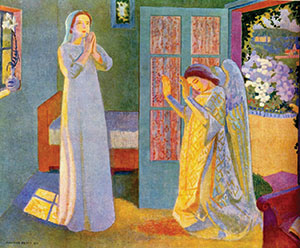
“Annunciation” (1913); oil on canvas by Maurice Denis (1870-1943; French).
Mary
Luke 1:26-38
In December, when the chill of winter begins to blow through my door as I retrieve my morning paper, young Mary haunts my reveries. Mary doesn’t barge into Advent with a shout in the desert and the scent of locusts and honey on her breath. She, a newly betrothed teenager, arrives quietly. Martin Luther thought she may have been doing housework when her life changed — something ordinary, like sweeping the floor.
“Greetings!” says the angel with all the subtlety of the pesky neighbor who knocks on your door too early in the morning and asks, “Is this a bad time?” Of course it’s a bad time. It’s a bad time for a teenager who has barely known her first kiss to be told that she, of all people, has been chosen to bear God’s own child.
A shudder runs through Mary’s heart. “Do not be afraid,” the angel Gabriel says, and those words make all the difference. She does not fear. She wonders. In an age plagued by fear and skepticism, Mary wonders at this gospel.
Could there have been other homes Gabriel visited? Could there have been other Marys whom this light-robed messenger urged not to fear, only to have the door slammed in his face? But this Mary wonders and then says, “Here am I, the servant of the Lord; let it be with me according to your word” (Luke 1:38).
Terry L. Morgan attends Christ the King Lutheran Church in Centerville, Ohio, and is supply preacher for Emmanuel Lutheran Church, Germantown, Ohio.

“Exodus”; woodcut byAzariah Mbatha (1941-; South Africa), who has lived in Sweden since 1969.
Moses at the Red Sea
Exodus 14
One of my favorite Bible stories is Moses and the Israelites at the Red Sea. Faced with a seemingly impossible situation with nowhere to turn, Moses tells the people: “Do not be afraid, stand firm, and see the deliverance that the Lord will accomplish for you today” (Exodus 14:13).
If you trust in the Lord and “stand firm,” God will deliver you from seemingly impossible situations. I love that promise and reassurance. Moses continues: “The Lord will fight for you, and you have only to keep still” (Exodus 14:14).
Wow. What a comfort to know that the Almighty Creator of the universe is fighting on our behalf. Turn your cares, worries and concerns over to God — trust in the Lord to deliver you in the time of your greatest need.
George M. Brickley attends First Lutheran Church in Malden, Mass.
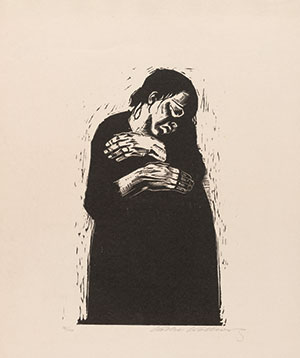
“The Widow,” plate 4 from “War” (Krieg) series(1921-22, published 1923); woodcut by Käthe Kollwitz (1867-1945; German); Museum of Modern Art, N.Y.
Parable of the widow and the unjust judge
Luke 18:1-8
When I was young I used to race sailboats. The only way to win was to keep my eye on the mark and get there first. The wind, tide and other sailors worked hard to get me off course. Sometimes I won, sometimes I lost, but I always tried. There was great satisfaction in trying.
Today I live in quiet desperation. I am unwell and often in pain. My goals are different now. Winning is when I get the daily newspaper sudoku right or make good banana bread.
My body is not much use, but believing that love is even greater than life itself, I pray for my family, for those in pain, and for justice and healing in our broken world. When I am weak and feel like giving up, when the wind is just too strong, I remember a verse from the parable of the widow and the unjust judge, where Jesus tells of the need to “pray always and not to lose heart” (Luke 18:1).
That widow in Luke’s parable had no status or power. She must have been unimaginably desperate to not only confront a judge who notoriously cared little for other people, but to continually return until he gave up and heard her case. Today I return again and again to God, a just judge, with my petitions. Sometimes I see my prayers answered and sometimes not.
Unlike the widow I’m lucky to have a wonderful husband, children and friends who care, but my struggles are all mine. No one else can take on that burden — except God. There’s great satisfaction in praying.
Jane McKinley attends Immanuel Evangelical Lutheran Church, Lakewood, N.J.

“The Story of Joseph” detail, “Joseph Interprets Pharaoh’s Dreams” (1986); serigraph in 34 colors by John August Swanson (1938-), the son of a Mexican mother and Swedish father who now lives in Los Angeles.
Joseph
Genesis 40
In a society that judged one’s intrinsic worth on social status, Joseph’s career went up and down like a yo-yo. He was the No. 1 son and then sold into slavery. He became his master’s right-hand man and then went to prison. He later found himself as Pharaoh’s right-hand man. Perhaps Joseph’s life informed Jesus’ teaching about each person’s unchanging, infinite worth: “The last will be first” (Matthew 20:16) and “whoever wishes to be great among you must be your servant” (Matthew 20:26).
Throughout his life, Joseph maintained continuous awareness of God’s presence and grace toward him, and so managed to excel at every task to which he put his hand. Above all, he let go of the many serious injustices he had suffered and lived as one without any grievances. Thus, for example, he had sufficient presence to reach out to other prisoners in need (Genesis 40:6-7).
For 30 years I prospered working in various professional capacities before becoming homeless. I’m still homeless. But Joseph’s example encourages me that, through grace and presence, God can and will continue to use my gifts, regardless of my circumstances. I can still be light to the world.
William Tell lives in Baltimore and blogs at www.williamatell.wordpress.com.
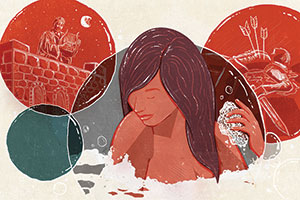
“David and Bathsheba” (2012), created using Photoshop by Jon Deviny (1982-), who lives in Bellingham, Wash.
Bathsheba
2 Samuel 11
Was she the innocent victim of rape by a king? Or a bored soldier’s wife deliberately tempting a bored king who was ordered not to go into battle? Of course, we’ll never know. But over the years there have been movies, books and much speculation about King David and the beautiful Bathsheba, his eighth and last official wife.
Her beauty and charm must have really enthralled him from a one-night stand to marriage and the promise that their second son Solomon would be king instead of his firstborn Absalom.
I admire Bathsheba’s boldness to inform King David of the results of their brief encounter, knowing at best she’d become part of his sizable harem and at worst ignored. Amazingly he married her after first deviously ordering her husband, Uriah the Hittite, to be put in the front line of battle to ensure his death and her official widowhood. Did she grieve for her husband? Or was she too overwhelmed by her good fortune to care much?
Was she happy? Content? God only knows. But she upset the royal genealogy and Bible history. Or was it God’s plan all along?
Patricia M. Kenning is from Littleton, Colo.
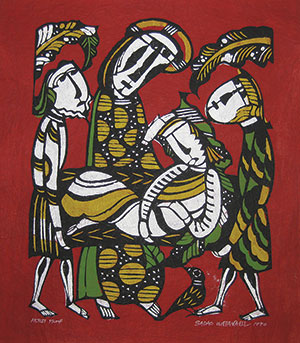
“Christ’s Pity of the Sick” (1970); mingei (folk art) print on kozo paper by Sadao Watanabe (1913-1996: Japan).
The healing of a boy with a spirit
Mark 9:14-27
A father brings his son to the disciples for healing, but they’re unsuccessful. The father approaches Jesus directly and makes it plain that he is bringing his child to him specifically. Then he gives a medical history like any parent speaking to a doctor might do on behalf of his nonverbal child.
As the parent of a nonverbal son who had seizures, every detail of this story rings true to me. I can relate to the father’s frustration with the disciples.
Jesus’ response to the father seems impatient. The only part the father really hears is when Jesus says, “Bring [your son] to me” (Mark 9:19).
I remember many doctors and therapists who said discouraging things before they agreed to see my son.
Seeing his son in the throes of yet another seizure, the father exclaims, “If you are able to do anything, have pity on us and help us” (22). Jesus’ answer that all things are possible to one who believes evokes from the father one of the great expressions of New Testament faith—“I believe; help my unbelief” (24).
Many times I have prayed that as I cared for my son or faced other challenges in my life.
Then things happen quickly. The crowd presses in. Jesus rebukes the spirit that had been causing the boy’s seizure. The boy falls limp. Cynics are already writing him off as dead. Jesus takes the boy’s hand and the two of them stand together. The evangelist doesn’t tell us what the father is doing. But I know. He is crying and praising God with all his being.
I read this story often during the 26 years I cared for my son. It helped me understand how Jesus shares our struggles. In 2012, Jesus took Matthew’s hand, raising him up to be with him. This was the Gospel story read at his funeral.
Susan B. Bianchi attends Holy Trinity Lutheran Church in Hershey, Pa.
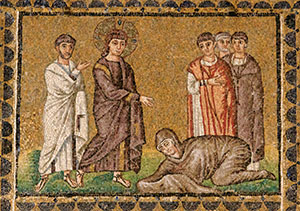
“Jesus Healing the Woman with an Issue of Blood”; mosaic in the Basilica di Sant’Apollinare Nuovo (sixth century), Ravenna, Italy.
The woman who touched Jesus
Mark 5:25-34
Scripture doesn’t reveal to us how old she was, nor does it give her name. It does confirm she had been dealing with chronic hemorrhaging for years and not getting better. In biblical times, a bleeding woman was considered unclean and untouchable, ostracized from family and community, and perhaps even dependent on charity for a living. I can only imagine how alone she must have felt.
It’s easy for me to empathize with the woman’s situation and her desperate need to find healing and wholeness. In boldly touching Jesus’ garment she expressed her faith that he was the one who could help her. And he did.
What endears me to this story is the woman’s boldness in approaching Jesus — no words, simply a touch made the connection for her. Jesus’ loving response and her courage remind me that anyone can approach the Lord with a problem. Even me.
Vivian J. Becker, Arlington Heights, Ill., is a retired pastor. She attends St. Mark Lutheran Church, Mount Prospect, Ill.

“Do Not Hold on to Me” (2013); Japanese gouache color and Chinese ink onKorean rice paper by He Qi (1948-; Chinese).
Jesus the Good Shepherd
Psalm 23; John 20:11-18
My favorite image of Jesus is as the Good Shepherd. In John 10, the Good Shepherd tells us that he knows his sheep and his sheep know him, and that he leads them forth by calling each by name. Hearing their names spoken by a familiar voice, they follow him. The key elements in this passage are voice and name.
One of my favorite Bible stories where this is lived out is the meeting of the Good Shepherd and one of his sheep on Easter morning, as told by John. Mary Magdalene, one of Jesus’ sheep, was crying outside the empty tomb when Jesus appeared. She mistook him for the gardener and didn’t recognize his voice. Then came the Good Shepherd moment. Jesus drew near and spoke one word — “Mirjam” (Mary). Hearing her name uttered in that familiar voice, Mary exclaimed, “Rabbouni” (teacher). This was the “aha” moment. Jesus knows us and calls us by name.
This story is so dear to me that when I visited the Church of the Holy Sepulchre in Jerusalem in 1977, after climbing the Calvary steps and then standing inside the empty tomb, I made a brief visit to the chapel that marks the traditional site of this sacred encounter.
Terrance J. Thompson II of Coconut Creek, Fla., attends three Christian congregations in Fort Lauderdale, Fla.



